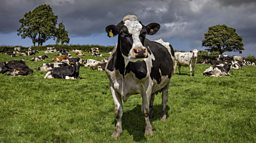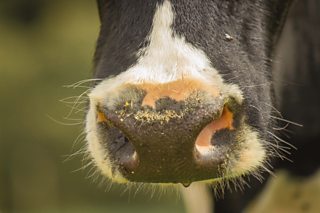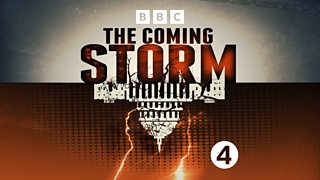The Cows are Mad: Ten things we learned about Mad Cow Disease
Before the Covid-19 pandemic, there was another sickness that once stalked the nation and turned things very strange for a while: in the 1990s, Britain was hit by an epidemic of a fatal neurological disease in cows that also began to kill humans. 30 years on, scientists and activists are still searching for answers to two big questions: where did Mad Cow Disease originally come from and how did humans get infected?
Here are ten things we learned from the 91热爆 Radio 4 series The Cows Are Mad – a tale of cannibal cows, competing origin theories and scientific dead ends.

1. There had been a sheep version of the disease but never one in cows
In 1985, a vet called Colin Whitaker was being called out to inspect cows in the Kent countryside who were acting strangely – spooked, nervous and on edge. After eliminating some potential causes, he began to suspect that a new bovine disease was emerging.
Clumps of killer rogue prion proteins form in the brain, and make holes, causing it to look like a sponge.
At the time, scientists knew about a sheep disease called scrapie that damaged the brain, creating sponge-like holes. There was a human one too that happened spontaneously, or could be passed down through families. But there had never been a cow version – until now.
When the government veterinary scientists ran tests on a cow head Colin sent them, they confirmed his fears: the sickness was a new addition to a family of fatal transmissible brain diseases.
2. The disease was named after its spongelike effect on the brain
Bovine Spongiform Encephalopathy – or BSE as we came to know it.
BSE is a prion disease. Prions are a kind of protein found all over the body but especially in the brain and nervous system. Sometimes, these proteins go wrong – for reasons still unknown – and change shape. And then, they change other prions too. Clumps of killer rogue prion proteins form in the brain, and make holes, causing it to look like a sponge.
3. Cow cannibalism spread the disease
In 1987, government epidemiologist John Wilesmith was tasked with a secret mission: to find out why cows were suddenly going mad, and how the madness was spreading.
He looked for links to vaccines or pesticides, but no patterns emerged. Then he wondered if meat and bone meal – a powder made from animal remains, and added to cattle feed – could be to blame for the spread. Could feeding cows to cows be recycling the disease?
Based on John’s evidence, three years after the first cases of BSE, the government told farmers they were no longer allowed to feed cows bone meal. They still didn’t know how the disease had started but the Feed Ban did halt the spread of Mad Cow Disease, proving one thing: cow cannibalism had spread the madness.
4. It took a decade for the effect of BSE to show in humans
When the disease first emerged in cows there was no scientific evidence, officials argued, that it could make the leap to humans. The government advice was clear: keep calm, and carry on eating cows. So that’s exactly what most people did, for a decade, until 1995. It was then that the first human cases of Mad Cow Disease, known as vCJD, began to emerge.
Stephen Churchill was the first to die, in May 1995. He was 19. Two more young people died that year. Ten died of confirmed vCJD in 1996, and another ten in 1997. The last person so far died in 2016. So far 178 people have died in the UK from vCJD – most of them young.
5. Parts of cows were banned by the pet food industry before they were deemed unsafe for humans
The government had banned cow spinal columns, brains, and spleens from the human food chain in the late 80s, because they were the main body parts where the infective BSE prion proteins multiplied. But the improved meat processing guidelines were still not being properly implemented, and scrapings from cow spinal columns were still making their way into cheap burgers and pies.

After cats began to fall ill and die from BSE, the pet food industry enforced even stricter guidance for food processing – which in turn led to the government enforcing stricter inspection at meat processing plants producing food for humans.
6. Some people argue that an old meat rendering plant infected the water supply
There is still no definitive scientific explanation as to how humans came to be infected with vCJD. While the general consensus is that it came from eating infected meat, not everyone believes this – after all, vegetarians got vCJD too.
It was in Kent that four of the earliest cases of human Mad Cow Disease emerged, known as “The Kent Cluster”. In that same county was Thruxted Mill – a meat rendering plant where leftovers from abattoirs and butchers were turned into fats for use in candles, cooking and cosmetics. Concerns were raised (by old employees and a local neurologist) that waste cow product – at the height of the BSE crisis – was being discarded down a well on the site of the mill.
The Environment Agency investigated and discovered that dead-cow-infused liquid from the rendering process had indeed been pumped into the well between the 1960s and 1980s. (The owners, who bought it in the 1990s, denied anything other than rainwater had been put in the well while they owned it.) Could this have resulted in BSE infecting the local source of drinking water? With the well now filled in with cement, nothing has ever been proved.
7. Another theory is that pesticides played a part
Before the days of Mad Cow Disease, cattle in Britain were being doused with a pesticide, used to kill grubs of a pest called the warble fly. The powerful pesticide killed the pesky flies by inflicting catastrophic nerve damage.
Mark Purdey was an organic farmer turned self-taught scientist who developed the theory that organophosphate pesticides had caused cow prion proteins to go rogue, causing BSE. Over the years, his theory evolved: he claimed that pesticides sprayed on the land could also explain the human form of BSE, vCJD.
Evidence is mounting that organophosphate pesticides, even at low doses, can cause brain damage in humans – especially children. Major producers of pesticides, however, maintain that any evidence is inconclusive.
The pesticide theory was explored - and then discarded - early on by scientists investigating BSE, and no research has proven a link between pesticides and BSE.
8. Some believe that vaccines could be to blame
Cow’s blood serum is used to grow some human vaccines. And so, in the late 80s and early 90s, health officials tried to find out how many cows potentially harbouring BSE might have been used in vaccines sitting on shelves at the time. With no tangible records kept, however, it was an impossible task.
Chronic Wasting Disease is a prion disease, just like Mad Cow Disease and CJD, but this time it鈥檚 affecting deer in the wild.
New rules were brought in to prevent cow parts from infected herds being used for new vaccines, and research published in 1993 showed it was very unlikely human vaccines could have been infected, but the public enquiry into BSE stated there could not be a 100% guarantee that vaccines at the time had been safe.
9. Could cows have caught BSE from humans?
Europe’s farming and chemical industries rely on the global trade in waste animal products, with animal leftovers from places like India and Pakistan being shipped to our shores. But in 1997, dockers in Dunkirk spotted something different in the cargo – human bones.
Some of the traded animal remains were picked up by bone collectors in India, who comb the banks of the Ganges – a place where many funerals also take place. Research published in The Lancet explored the scenario that among the animal parts exported from India were also the bones of people who might have been infected with the human form of CJD. Those infected bones were then used in the production of cattle feed. Could it be that rather than cows giving humans Mad Cow Disease, we gave it to them?
Ultimately, government scientists dismissed this theory, saying the chances of it happening were too remote.
10. History could be repeating itself, with deer
In the US, there’s another animal brain disease is spreading. Chronic Wasting Disease is a prion disease, just like Mad Cow Disease and CJD, but this time it’s affecting deer in the wild. It’s leaving them confused, distressed, walking in circles by the side of the road. And like BSE, it’s fatal. But CWD is also far more infectious: the rogue prions can transfer via saliva and droppings, and have even been found in plants in deer-heavy regions.
As yet, there’s no evidence that CWD is going to jump species. But Americans who hunt deer are being advised to test their kills before cooking them up. And, because of the prion disease time lag, no one will know for sure if it has jumped to humans until people start dying.
Dr. Michael Osterholm from the Centre for Infectious Disease Research and Policy at the University of Minnesota has been warning another Mad Cow Disease could be on the horizon since 2019.
“Can I say that we're going to actually see a human related CWD?” says the scientist. “I don't know. I wouldn't want to bet against it right now.”
More 91热爆 Radio 4
-
![]()
Fever: The Hunt for Covid's Origin
Politicised, polarised, and caught up in a chaos of coincidences and conspiracy theories: where did Covid come from?
-
![]()
The Coming Storm
QAnon and the plot to break reality. Gabriel Gatehouse takes a journey into the dark undergrowth of modern America.
-
![]()
Marianna in Conspiracyland
What happened to the people who fell down the rabbit hole into a world of conspiracy theories? Marianna Spring investigates.
-
![]()
Life Changing
Dr Sian Williams talks to people who have lived through extraordinary events that have reshaped their lives in the most unpredictable ways.





